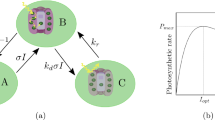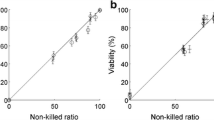Abstract
Microalgae are often seen as a potential biofuel producer. In order to predict achievable productivities in the so called raceway culturing system, the dynamics of photosynthesis has to be taken into account. In particular, the dynamical effect of inhibition by an excess of light (photoinhibition) must be represented. We propose a model considering both photosynthesis and growth dynamics. This model involves three different time scales. We study the response of this model to fluctuating light with different frequencies by slow/fast approximations. Therefore, we identify three different regimes for which a simplified expression for the model can be derived. These expressions give a hint on productivity improvement which can be expected by stimulating photosynthesis with a faster hydrodynamics.




Similar content being viewed by others
Notes
This property can be shown by remarking that the Haldane curve B SS(I) is always under its initial tangent for I = 0. Straightforward geometrical considerations based on Thales Theorem prove this result.
References
Benemann JR (1997) CO2 mitigation with microalgae systems. Energy Convers Manag 38:475–479
Bernard O (2011) Hurdles and challenges for modelling and control of microalgae for CO2 mitigation and biofuel production. J Process Control 21(10):1378–1389
Bernard O, Gouzé JL (1995) Transient behavior of biological loop models, with application to the Droop model. Math Biosci 127(1):19–43
Bernard O, Gouzé JL (1999) Nonlinear qualitative signal processing for biological systems: application to the algal growth in bioreactors. Math Biosci 157:357–372
Carvalho AP, Meireles LA, Malcata FX (2006) Microalgal reactors: areview of enclosed system designs and performances. Biotechnol Prog 22(6):1490–1506
Celikovsk S, Stys D, Papacek S, Celikovsky S, Ruiz-Leon J (2007) Bilinear system as a modelling framework for analysis of microalgal growth. Kybernetika 43(1):1–20
Chisti Y (2007) Biodiesel from microalgae. Biotechnol Adv 25:294–306
Droop MR (1968) Vitamin B12 and marine ecology. The kinetics of uptake growth and inhibition in Monochrysis lutheri. J Mar Biol Assoc 48(3):689–733
Droop MR (1983) 25 Years of algal growth kinetics, a personal view. Bot Mar 16:99–112
Eilers PHC, Peeters JCH (1988) A model for the relationship between light intensity and the rate of photosynthesis in phytoplankton. Ecol Model 42(3–4):199–215
Eilers PHC, Peeters JCH (1993) Dynamic behavior of a model for photosynthesis and photoinhibition. Ecol Model 69(1–2):113–133
Han BP (2001) Photosynthesis-irradiance response at physiological level: a mechanistic model.J Theor Biol 213:121–127
Han BP (2002) A mechanistic model of algal photoinhibition induced by photodamage to photosystem-II. J Theor Biol 214(4):519–527
Huntley M, Redalje DG (2007) CO2 mitigation et renewable oil from photosynthetic microbes: a new appraisal. Mitig Adapt Strateg Glob Chang 12:573–608
Lange K, Oyarzun FJ (1992) The attractiveness of the Droop equations. Math Biosci 111:261–278
Luo HP, Al-Dahhan MH (2004) Analyzing and modeling of photobioreactors by combining first principles of physiology and hydrodynamics. Biotechnol Bioeng 85:382–393
Mairet F, Bernard O, Masci P, Lacour T, Sciandra A (2011) Modelling neutral lipid production by the microalga Isochrysis affinis galbana under nitrogen limitation. Biores Technol 102:142–149
Metting FB (1996) Biodiversity and application of microalgae. J Ind Microbiol Biotechnol 17:477–489
Monod J (1950) La technique de culture continue. théorie et applications. Annales de L’intiut Pasteur 79:390–410
Olaizola M (2003) Commercial development of microalgal biotechnology: from the test tube to the marketplace. Biomol Eng 20:459–466
Perner-Nochta I, Posten C (2007) Simulations of light intensity variation in photobioreactors. J Biotechnol 131:276–285
Pulz O (2001) Photobioreactors: production systems for phototrophicmicroorganisms. Appl Microbiol et Biotechnol 57:287–293
Rehak B, Celikovsky S, Papcek S (2008) Model for photosynthesis and photoinhibition: parameter identification based on the harmonic irradiation O2 response measurement. IEEE Trans Autom Control 53(special Issue):101–108
Sari T (2007) Averaging for ordinary differential equation and functional differential equations. In: van den Berg I, Neves V (eds) The strength of nonstandard analysis, Springer, New York, p 286–305
Sciandra A, Ramani P (1994) The limitations of continuous cultures with low rates of medium renewal per cell. J Exp Mar Biol Ecol 178:1–15
Sialve B, Bernet N, Bernard O (2009) Anaerobic digestion of microalgae as a necessary step to make microalgal biodiesel sustainable. Biotechnol Adv 27:409–416
Prezlin V (1981) Light reaction in photosynthesis. Can. J Fish Aquat Sci 210:1–43
Vatcheva I, de Jong H, Bernard O, Mars NJL (2006) Experiment selection for the discrimination of semi-quantitative models of dynamical systems. Artif Intel 170:472–506
Vejrazka C, Janssen M, Streefland M, Wijffels R (2011) Photosynthetic efficiency of Chlamydomonas reinhardtii in flashing light. Biotechnol Bioeng 108(12):2905–2913
Wijffels RH, Barbosa MJ (2010) An outlook on microalgal biofuels. Science 329(5993):796–799
Wu X (2001) A model integrating fluid dynamics in photosynthesis and photoinhibition processes. Chem Eng Sci 56(11):3527–3538
Acknowledgements
This work was carried out in the framework of the ARC Nautilus funded by INRIA.
Author information
Authors and Affiliations
Corresponding author
Appendix A: analytical derivation
Appendix A: analytical derivation
A1. Low frequency signal
Equation (11) is taken as an expression for the productivity of the photosynthetic system and the mean value during one period is taken. The domain of the integral can be restricted to the light phase of the cycle only, since during the dark phase B = 0.
By replacing A by 1 − B − C, and assuming that A rests in its equilibrium while C is periodically oscillating:
we get:
Analogously, the differential equation for C can be reformulated
This equation can be easily solved. C 0 is determined by applying the periodic boarder condition. Several simplification steps lead to the following expression for the integral:
Using expression Eq. (38), we get expression Eq. (18).
A2. High frequency signal
Under the precondition that the periodicity of the signal is short, we already showed that the dynamics of C is negligible. In contrast, the transition process of A and B has to be taken into account. The expression for the mean growth rate has to account for the entire period, since B ≥ 0 during the dark phase. The expression for the growth rate turns to:
The first integral being during the light period and the second during the dark period. To solve the integrals, an expression for A(t) has to be determined from the differential equation. By assumption that C is a constant value and with periodical boarder conditions, Eq. (13) can be solved with the result:
With Eqs. (42) and (13), periodical boarder conditions and the assumption \(\dot{C} = 0\), a value for C can be determined to:
with the expressions:
Knowing the value of C, the integrals in Eq. (41) can be resolved and B can be formulated as:
A3. Proof of monotony
Low frequency
It can be shown, that the function:
is strictly monotonic decreasing in x and it holds \(\Phi(x,a,b) >0\) for a > 0, b > 0, x > 0.
Further, \(\bar{B}_{\text{slow}}(I,T)\) can be defined as follows:
with \(\chi = k_\text{r} + k_\text{d} \frac{(\sigma I)^2}{1+ \tau \sigma I}\), consequently, \(\bar{B}_{\text{slow}}\) is strictly monotonic decreasing in T.
High frequency
\(\bar{B}_{\text{fast}}\) can be written as:
Derivation with respect to T yields:
Taking into account the parameters, it is clear that the fraction is positive. With the property \(\frac{\partial \Phi ( 1/ \tau, \eta , T)}{\partial T} < 0\), it is shown that \(\bar{B}_{\text{fast}}\) is strictly monotonic decreasing with respect to T.
Rights and permissions
About this article
Cite this article
Hartmann, P., Béchet, Q. & Bernard, O. The effect of photosynthesis time scales on microalgae productivity. Bioprocess Biosyst Eng 37, 17–25 (2014). https://doi.org/10.1007/s00449-013-1031-2
Received:
Accepted:
Published:
Issue Date:
DOI: https://doi.org/10.1007/s00449-013-1031-2




